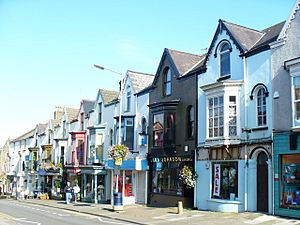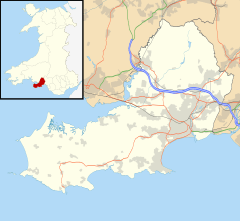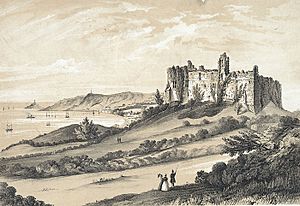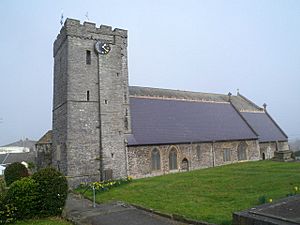Oystermouth facts for kids
Quick facts for kids Oystermouth
|
|
|---|---|
 Shops in Oystermouth |
|
| Area | 2.01 km2 (0.78 sq mi) |
| Population | 4,160 (2011 census) |
| • Density | 2,070/km2 (5,400/sq mi) |
| Principal area | |
| Ceremonial county | |
| Country | Wales |
| Sovereign state | United Kingdom |
| Post town | SWANSEA |
| Postcode district | SA3 |
| Dialling code | 01792 |
| Police | South Wales |
| Fire | Mid and West Wales |
| Ambulance | Welsh |
| EU Parliament | Wales |
| UK Parliament |
|
| Welsh Assembly |
|
Oystermouth (in Welsh: Ystumllwynarth) is a village in the Mumbles area of Swansea, Wales. It is part of the wider Mumbles community. This historic village is known for its beautiful coastline and the famous Oystermouth Castle.
Contents
Understanding the Name of Oystermouth
The original Welsh name for this area was "Caer Tawy." This means "the fort of the river Tawe."
The modern Welsh name is Ystumllwynarth. This name has been around for a long time, even appearing in old Welsh stories. Some believe it means "a place of defense on a hill." The English name, Oystermouth, might come from a mix-up of the Welsh name. It also sounds like it relates to the many oyster beds found here in the past. This is called a folk etymology, where a name sounds like it means something else.
A Glimpse into Oystermouth's Past
Oystermouth has a long history. When the local church was fixed up in 1860, workers found pieces of Roman floor tiles. These tiles were called tessellated pavement. Roman coins were also found in the village in 1822 and 1837. These discoveries tell us that a small Roman settlement likely existed here a very long time ago.
The name "Caer Tawy" also suggests that Welsh people built a fort here even before the Norman castles in Oystermouth and Swansea were constructed. The famous Oystermouth Castle itself dates back to the 12th century.
Exploring Oystermouth Today
Oystermouth is a village with many homes, stretching from the northwest to the southeast. The sea surrounds it to the east and south. There are two hills, Rams Tor and Mumbles Hill, with very few buildings. Mumbles Hill is now a special nature reserve, looked after by the local council.
While Oystermouth and Mumbles are separate places, many people think of them as one. Local buses might say "Oystermouth," but most people living there would say they live in Mumbles.
The area has beautiful beaches, including the southern part of Swansea Bay, Bracelet Bay, and Limeslade Bay. From Mumbles Head, you can see amazing views of Swansea, Port Talbot, and the distant hills of the South Wales Coalfield. Oystermouth is also home to the Oystermouth Cemetery.
The Historic Swansea and Mumbles Railway
Oystermouth was once served by the Swansea and Mumbles Railway. This was one of the very first passenger train services in the world! It ran along the shoreline and was used in the 1800s to carry limestone and coal. The railway stopped running in the 1960s. Today, its old path is a popular route for walking and cycling.
Churches in Oystermouth
Oystermouth has two churches that are part of the Church in Wales. These are All Saints' Church, Oystermouth and Norton Mission Church. All Saints' Church is very old, dating back to the 12th century. It has had parts added in the 1800s and is recognized as a Grade II heritage building.
In 2012, Rowan Williams chose the title Baron Williams of Oystermouth when he retired. He was previously the Archbishop of Canterbury, a very important leader in the Church of England.
Oystermouth Castle: A Medieval Fortress
Oystermouth Castle is a well-preserved castle from the 12th century. It sits on grounds with fantastic views over Swansea Bay. The powerful de Braose family, who were Lords of the Gower, rebuilt it using stone.
Even King Edward I of England visited the castle briefly in 1284. By the 1500s, the castle was no longer used and fell into ruins. Today, it's a popular historical site to explore.
Local Government and Representation
Until 2022, Oystermouth was an electoral ward. This means it was an area that elected its own local representative. The ward included parts of Oystermouth, Mumbles, Thistleboon, and Limeslade. It was bordered by Newton to the west and West Cross to the north. Swansea Bay formed its southern and eastern borders. Around 4,100 people lived in the ward in 2010.
After a review of the ward boundaries, Oystermouth and Newton wards were combined. They now form a new ward called Mumbles. This new ward is represented by three local councillors.





